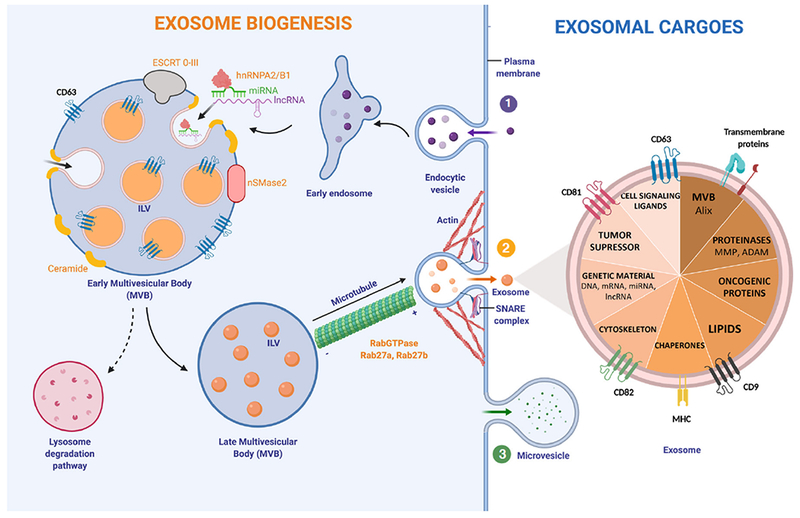Figure 1.

Exosome biogenesis and major exosomal cargoes. (1) Exosome biogenesis starts with the formation of an endosome from the plasma membrane. The successive inward budding of the endocytic vesicle generates ILV, which will generate a MVB. This step can be controled by two pathways; ESCRT-dependent (ESCRT 0-III complex) or ESCRT-independent (nSMase2). Exosomal cargoes approach the MVB membrane in order to be loaded into exosomes. Specifically, RNA-binding molecules bind to miRNAs (hnRNPA2/B1) and lncRNAs to sort them. Other molecules involved in exosomal cargo loading are tetraspanins: CD63, CD81, CD82 and CD9. The number of exosomes released by the cell can be regulated by the lysosomal degradation. In this situation, the MVB and a lysosome fuse together, degrading the MVB’s content. Rab27a/b GTPases regulate cellular vesicle trafficking. Microtubules guide the MVB to the cell membrane. Actin cytoskeleton also helps in the MVB docking. (2) The SNARE complex is responsible for the blending of plasma membrane with the MVB. When exosomes are delivered into the extracellular medium, they reach out target cells by using MHC and other transmembrane proteins and receptors. Exosomes can transport and transfer a huge variety of exosomal cargoes. (3) Microvesicle biogenesis follows a different pathway: budding of the plasma membrane produces microvesicles. hnRNPA2/B1: heterogeneous nuclear ribonucleoproteins A2/B1; ESCRT: endosomal-sorting complex required for transport; MVB: Multivesicular Body; ILV: Intraluminal vesicle; SNARE: soluble N-ethylmaleimide-sensitive fusion attachment protein receptor; MHC: major histocompatibility complex; MMP: matrix metalloproteinase; ADAM: a disintegrin and metalloproteinase
